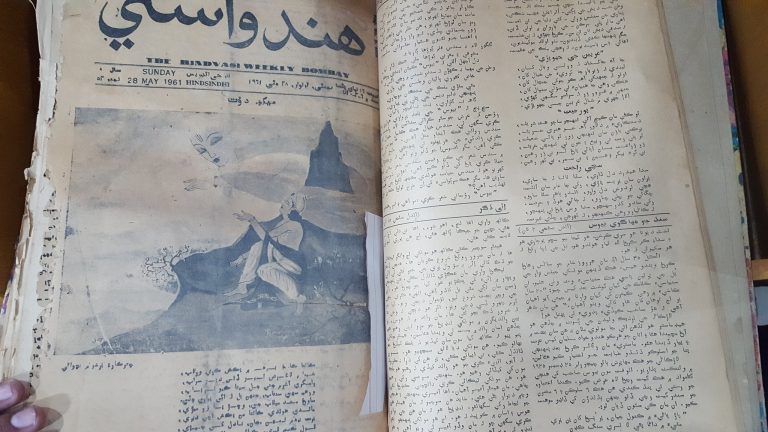
Hindvasi is one of the oldest newspapers of Sindhi language currently being published from Mumbai. During British Raj it faced many trials and tribulations and was even charged of sedition. This is the historical record of that sedition case.
Late Prof. Dr. Allah Rakhio Butt
On 26 April 1919 Jethmal’s house and the Hindvasi office were searched and he was arrested for an offence under section 147 ICP, but was released on bail the same evening. The message was quite clear. But the fearless fighter was relentless to fight back and did not bow or bend. On 15 May he was again arrested for two offences under section 124 A (Sedition) and 153 A (Racial Hatred) of the Indian Penal Code. The action was based on his article published in the Hindvasi of April 5, headed “Martyrdom in Delhi”. He immediately employed two Sindhi lawyers and moved bail applications at Hyderabad and Karachi, but both of his pleas were rejected by the ADM, and the Additional Judicial Commissioner of Sindh at Hyderabad and Karachi respectively. The rejection of bail pleas in an offence bailable supplied grounds for believing that government had made up its mind to make an example out of the popular political figure of Sindh.
The prosecution began on May 29, 1919 the accused engaged four local lawyers to defend him. On that day court recorded the evidence (statements) of seven witnesses namely Messer Jaffery, Junior Superintendent of Delhi Police, Nabi Bux M. Hussain, Native Assistant to the Commissioner In Sindh, Kirkpatrick, European D.S.P of Hyderabad, Mirza Kalich Beg, retired Deputy Collector and eminent Sindhi writer, Rai Bahadur Diwan Bulchand Dayaram, B.A. Principal of the N.H. Academy Hyderabad, for last 22 years and Diwan Lilaramsing Watanmal retired first class sub-judge. Nabi Bux M. Hussain translated into English the April 5 article for the Commissioner in Sindh and so did the last named three Sindhi scholars for Tahilram, D.S.P Hyderabad.
The most exciting aspect of their evidence (statement) related to the translation of the quotation from Shah-jo-Risalo, the magnum opus of the Sindhi literature, with which the Hindvasi April 5 article opened. The couplet related to the sur Kalyan, Chapter 5 of the Risalo and ended with the words “Kusan jo Kopu wahe.”
All three scholars apparently used different words while translating the extracts from the Risalo but with no difference of the message conveyed by the couplet. Mirza Kalich Beg said: “The quotation referred to drinkers cutting their head at the wine-shop. In other words; it meant that the price of wine was the head.”
Diwan Bulchand believed that meaning of quotation at the top of the article was: “At the shop of wine-seller there is a stream of slaughter. The esoteric meaning was self-renunciation. The poet said: cut off your head so that you may be accepted by God.”
Diwan Lilaramsing who himself was translator of the Shah-Jo-Risalo into English thought that the translation of the couplet was: “Those left behind made ready their heads. Do not consider yourself inferior. So that you may not see the heads of those in front (i.e. the brave) lying on the ground. At the shop of wine-seller, there is a terror of massacre.”
On 29 May 1919, evidence (statements) of the seven witnesses was recorded. On the same day the prosecution case was closed and the accused was charged with two offences sedition and inciting racial hatred under section 124-A and 153-A of the Indian Panel Code.
The manner in which things were moving clearly indicated the intentions of the administrative machinery of which the young and inexperienced executive officer acting as the magistrate was a part. The accused had no option, but to fight back bravely. He employed Baptista, Bar-at-Law the most experienced and expensive lawyer of Bombay (Mumbai) to defend him.
On June 4, 1919 the Hindvasi sedition case resumed again. The couplet of Shah Latif as translated by three Sindhi scholars came under extensive discussion. Diwan Lilaramsing was cross-examined and said: “The 1st paragraph (of the article) was consistent with Shah’s quotations, and Shah’s teaching. The quotation did not convey to him the idea of murder, because he had read Shah. He had read the article carefully. In the last paragraph the editor expressed what attitude of the people should be after the incidents at Delhi. The last paragraph condemned most emphatically the violence in any form, praised the men who suffered in Delhi. The editor praised the heroic act of Mahatma Munshiram and in-calculated the doctrine which Shah preached.”
The most outstanding scholar of the day Mirza Kalich Beg was also crossed examined. He said: “The article showed that the writer was inculcating non-violence. Shah was recognized as one of the very best Sufis and the very name of Shah Latif was a guarantee against violence and assassination. He preached the doctrine of self-suffering and self-sacrifice, the best way to attain salvation. The quotation in itself would mean that lovers offered themselves for sacrifice.”
All three Sindhi scholars gave evidence (statement) for the prosecution and established the innocence of the accused.
(Continues)
_________________
Courtesy: Wise Sindh